“Rising costs erode the competitiveness of Florida strawberries and squeeze growers’ profit margins. Combined with rising imports of strawberries from Mexico . . ., these trends have posed serious challenges to the industry.”
Such is the conclusion of a report from the University of Florida, and it has been repeated often. https://edis.ifas.ufl.edu/publication/FE1013
But a new report on the strawberry and blueberry industries, issued by USDA’s Economic Research Service (ERS) in September, suggests another, possibly more important, reason. The Changing Landscape of U.S. Strawberry and Blueberry Markets: Production, Trade, and Challenges from 2000 to 2020 (usda.gov)
“Fresh strawberry imports increased significantly in the last two decades, particularly from Mexico,” notes the report. “Fresh strawberries imported from Mexico reached a record high of 431 million pounds in 2020.”
Nevertheless, as of 2020 (the last year studied by the report), imports still only accounted for 14 percent of total U.S. fresh strawberry consumption. By far the largest part of consumed fresh strawberries come from California, which accounts for some 90 percent of the crop grown in the U.S.
“While Mexican strawberries have an almost year-round presence in the U.S. market, approximately 85 percent of Mexico’s U.S.-bound shipments enter the market during winter and spring months.”
Florida’s strawberry shipments occur almost entirely from the months of December through April, the report also indicates, meaning that Mexico and Florida go nose to nose in competition during these months. This fact accounts for often bitter complaints about Mexican imports eroding the Florida market (something similar is claimed with fresh tomatoes).
Can Florida’s problems be blamed entirely on Mexico, as the state’s industry frequently alleges? One revealing detail has to do with organics.
“U.S. consumer demand for organic blueberries and organic strawberries drove the growth in domestic and foreign production over the last two decades,” says the report. “The farm value of organic strawberry sales in the United States rose from $80 million in 2008 to $300 million in 2019.”
We are also told that “organic strawberries are a smaller part of production in Florida. In 2019, 680 acres were devoted to organic strawberries in Florida compared with 14 acres in 2008.”
In 2022, total strawberry acreage in Florida was 10,600, according to USDA’s National Agricultural Statistics Service (NASS). https://www.nass.usda.gov/Quick_Stats/Ag_Overview/stateOverview.php?state=FLORIDA
By contrast, “from 2008 to 2019, more than 75 percent of organic strawberry acres harvested in the United States were in California,” says the report. “In 2020, the California Strawberry Commission reported 4,624 acres of organic strawberries, 13 percent of the strawberry acreage in California.”
If we put these facts together, we are inching toward the conclusion that, in the strawberry industry at least, Florida’s problems may lie in its own lack of market responsiveness. If growth is in organics and Florida does not follow along, it has itself to blame in part for any market erosions.
This rather unpleasant conclusion must, I think, be taken into account in discussions of competition between Mexico and Florida.



